Garden Glimpses: Made in the Shade
I’ve put a lot of time, energy and money into establishing a diverse shade garden under the canopy of the paper birch and Norway maple in the southwest corner of the yard. Flanked by a large, now ancient, stand of mixed lilacs in the south and the new eight-foot fence in the west, further screening it from the sun, the area cried out for development, and after three years, my efforts are beginning to pay off. The problem was the rootiness of the area, the lack of proper amendment to the dense clay soil, and the insatiable appetite for moisture from the shallow-rooted birch, which creates a dry shade environment in its drain field.
I won’t pretend I’ve solved all these issues, but I’ve managed to find plant partners willing to work with the conditions offered, and these are now settling in nicely. Anchor plants like hydrangeas, hostas and chokeberries are thriving, spotlighted elements such as ferns, native geraniums, and spring ephemerals are gaining heft, and groundcovers are beginning to fill the spaces between them. It’s been a long row to hoe, but things are finally approaching the vision I had when I began.
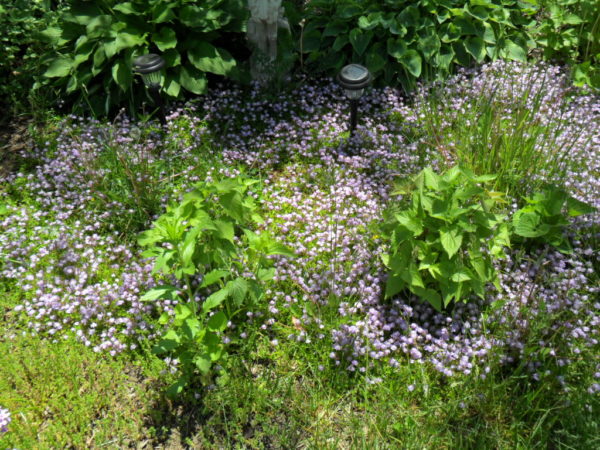
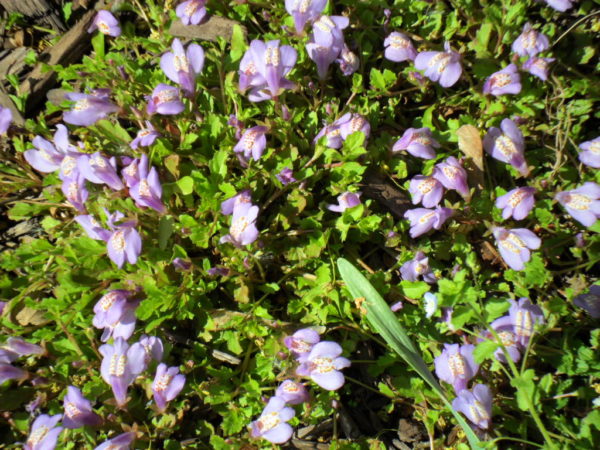
Starting from the ground up, how ‘bout them groundcovers? Two years ago at my local perennial farm, I came across a 1×2-foot solid, undivided flat of a low-growing green mass I had never seen before, with miniature, hatch-edged, spoon-shaped leaves, sporting a few pale purple blossoms on foreshortened stems, that resembled orchids. “Hey, Kay! What’s this?” I asked my favorite plantswoman. Legally blind, she adjusted her coke-bottle-thick glasses, peered at it a moment, then replied, “Oh! That’s mazus reptans.”
“Mazie who now?”
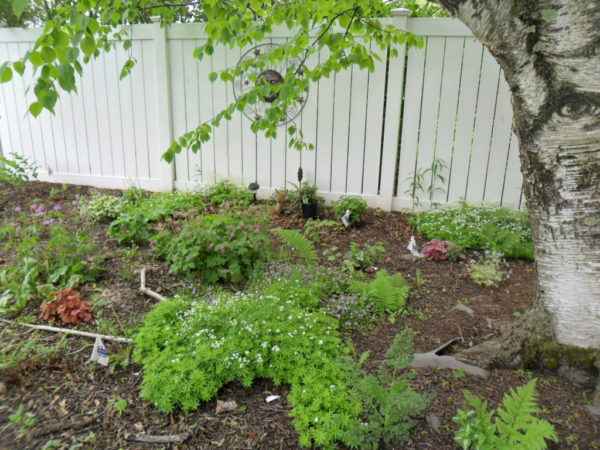
“Not Mazie – mazus. It’s a groundcover; we get it from my daughter, where it grows like a weed. It’ll take light foot traffic, too.”
“What kind of light does it like?”
“It’ll grow anywhere, shade or sun, but you’ll get a little more bloom with medium light.”

Being in dire need of covering ground, I decided to give it a try. “Split it,” advised Kay. “Before you know it, you’ll have more than you know what to do with.”
So I took it home, duly divided the flat into eight, and spaced them randomly throughout the garden, wherever I had a gaping hole between plantings, so long as there was some shade now and again through the day.
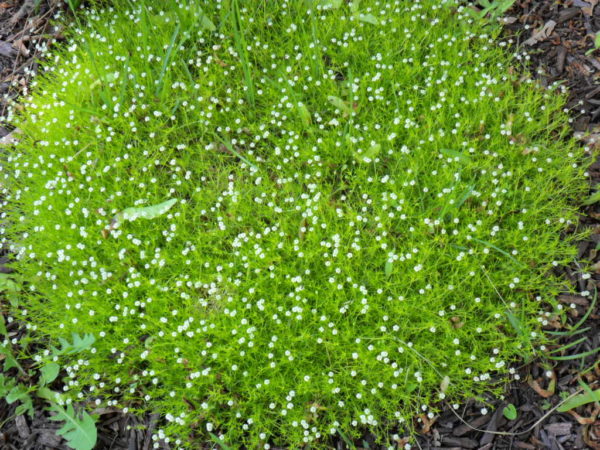
Three springs later, I couldn’t be more pleased. What had been isolated blobs of green are now vast pampas of verdure, stunningly carpeted with lilac blossoms three weeks every May. There is occasional sparse rebloom in late summer, but when mazus likes where it is, the spring flowering is so dense as to almost obscure the foliage. Mazus keeps down most weeds very well, with the unfortunate exception of grass, which is very difficult to eradicate once it’s established, without ripping out the mazus with it. So a couple patches have largely disappeared, but what remains forms ever-widening circles of lush greenery.
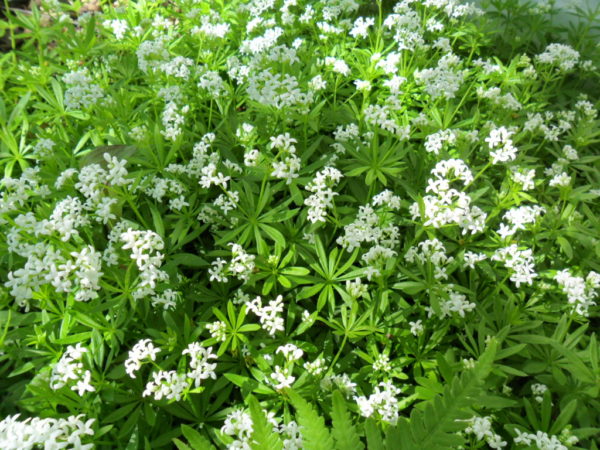
Irish moss is another wonderful groundcover that I wasn’t familiar with before moving here. Very low-growing, as the name implies, it’s not a true moss, but rather a member of the pink and carnation family. Chartreuse green rounds of fine, almost feathery foliage are punctuated in spring with miniscule white teacup blossoms, five-petaled, with some random rebloom throughout the growing season. Slower to spread than mazus, it’s denser, and lets very little else through, creating islands of almost perfectly circular dimension.

Next up are sweet woodruff and archangel, both of which I also cultivated in my postage stamp backyard in Philly. Woodruff is an amazing plant, very lush, about 5-6 inches tall, a great spreader that will fan out and dominate an area in very little time. The leaves, which are bright green and bladey, radiate in “shelves” of consecutive whorls around a center stem, like so many floors of an apartment building with a central elevator. It enjoys the shade and blooms very well with low light, though the dappled shade of the birch is what it seems to like best – again, a little more light means a lot more bloom, but too much will burn it out. Another May bloomer, woodruff sends up masses of small four-petaled, equal cross blossoms, with up to a dozen or so per delicate stem, rising an additional inch or two above the massed foliage.

But for speed of spreading, archangel can’t be beat. This stunning variegated groundcover, medium green with thick silver margins, will thrive in any light level, but blooms best with a bit of shade during the day to cool it. It can grow to a foot in height, and spreads by sending long trailing strands from a central cluster, which root where they touch. In short order it has completely taken over a large, 10 x 6 space under the failing white birch clump, choking out any weed that even thinks of growing there. Lovely throughout the growing season, it’s late April and early May when archangel really shines. A mint relative, archangel blooms profusely with tall spires of bright yellow, snapdragon-like flowers which circle the stem in layers.
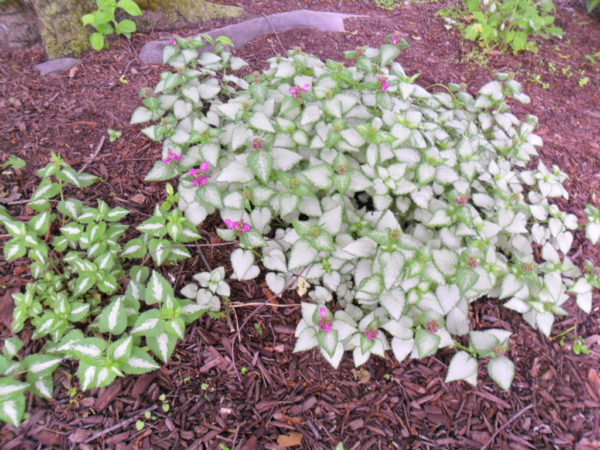
Archangel is a Lamiastrum, meaning “lamium-like”, and there are many other related groundcover options in the Lamium family proper, with a wide variety of foliage and bloom colors. Most are not as quick-growing or invasive as archangel, tending toward more dense, low-growing mounds gradually spreading out from a central point. I’m currently growing two, Purple Dragon and Pink Dragon, both with foliage that is variegated, but predominantly silver-white, and blossoms colored as you might expect from their names (I assume the “dragon” appellation comes from the flower’s similarity to a snapdragon bloom). Purple Dragon, in particular, is a vigorous seeder, with smaller “colony” plants sprouting anywhere within a ten-foot radius. As a hybrid, some of these children are half-breeds, reversions to an earlier variety from which Purple Dragon was bred, with greener foliage and less prominent markings; these are babies still which have yet to bloom, so I’m eagerly awaiting the flower color. The main drawback to lamium is that it tends to look rather ragged as summer’s heat maximizes, to the point where you wonder if it’s given up the ghost. But come the spring, it’s back with a vengeance, beefier than the year before!

Tiarella is another wonderful groundcover, larger-leafed than many, with lime green foliage veined with maroon-brown, resembling maple leaves in their structure. This is a slow grower, but so dense as to preclude weedy interlopers. The plant is also known as “foamflower”, from its tall spikes of diminutive pure white blossoms, delicately ethereal, borne in clustered elegance three to five inches above the foliage, at its height in mid-late May. The bottle-brush-like, closely spaced spikes look like so many fairy wands, raised aloft to enchant unwary passersby.

Lastly for groundcovers, let’s talk vinca. And talk about invasive! I bought my first vinca, an unusual and striking green-and-yellow variegated strain, in 2006, for a hanging basket in the West Philly garden. Vinca is ideal for this purpose, sending out long tendrils that bloom a medium-sized periwinkle-blue flower at random intervals, and add dangling dimension to an elevated pot. At the end of the season, I noticed that some of the tendrils had grown so long as to touch the ground, and had rooted in the soil, but didn’t think much of it. I just cut the anchor vines and tossed the contents of the pot, which were largely annuals, onto compost.
And then the next spring came. Suddenly I’m seeing little tufts of vinca in the yard beneath where the basket had been, each sending forth fresh tendrils of their own. Within three years the yard was a mass of it!
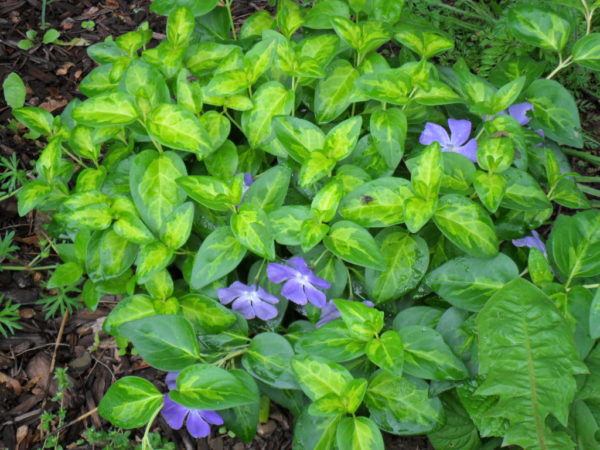
Despite being fully aware of this tendency to subdivide and conquer, I brought some with me when I moved to Nazareth, and now, three years later again, I am once more consumed by vinca, almost literally. It’s especially fond of the woody edge, where shade meets sun, but it will pop up almost anywhere. Right now it’s at its prettiest stage, in fresh-faced clumps of relatively tame new shoots, about 8” in height, with dots of blue interspersed bringing a much-needed pop of color to the lull between spring’s early exuberance and summer’s floral bounty.
But soon those shoots will become trailers, and those trailers will root, and next spring there will be tenfold vinca. It’s well-nigh impossible to eradicate now, even if I wanted to, so take this gardener’s advice, and save yourself! If you haven’t yet planted vinca … don’t!
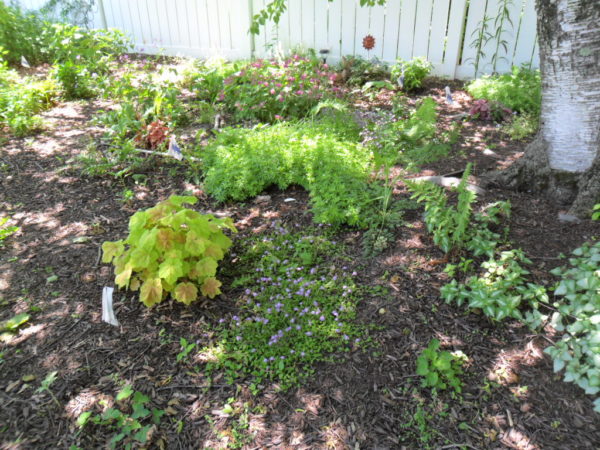
Spring ephemerals have become an obsession for me of late, early bloomers which leaf out, blossom, and then die back to the soil as summer’s heat waxes. Last year I invested quite a bit in product and labor to have 100 native plants installed in the shade garden. They came as ten bareroot specimens each of ten common woodland varieties, which we divided in half, for twenty plantings in total.
That first season was a huge disappointment; barely half of the varieties sprouted at all, and very few of those which did emerge offered any bloom. But I had flagged their resting places, and kept them well-watered throughout the long hot summer, hoping against hope that they would somehow survive the dry season, and the spring might bring a better showing.
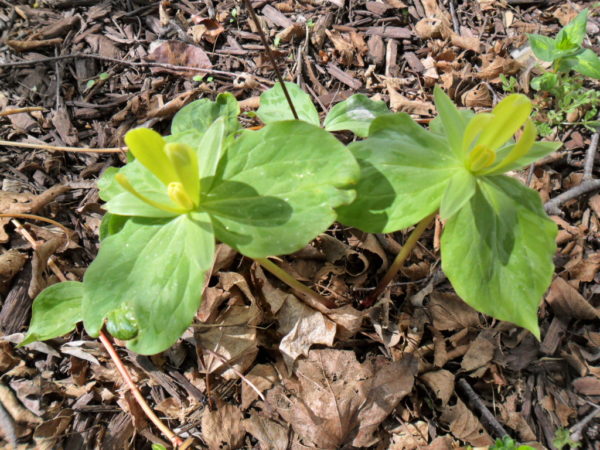
And so it transpired – this season saw the emergence of green in 19 of 20 patches, and although several varieties have yet to bloom, all are doing well and expanding. The purchase included two trillium types – luteum, with its speckled variegated green-brown foliage and strangely shaped pale-yellow blossoms, like three dolphin flippers raised in supplication; and recurvatum, with deep burgundy-brown flowers, which has yet to bloom for me. Trillium is so-named for the number of its parts, both petals and leaves, which always come in three.

Celandine poppy is a wonderful new addition that I’ve come to love in its first season of bloom here. Bright sunburst-yellow blossoms open sequentially atop willowy stems about a foot in height, with foliage that looks nothing like a poppy to my eye. But after bloom, when the seed forms, the resemblance is clear, with drooping down-turned beige pods finely furred in white. Celandine poppy has a very long bloom time as spring ephemerals go, providing moderately profuse bloom for a full three weeks when conditions aren’t too hot.
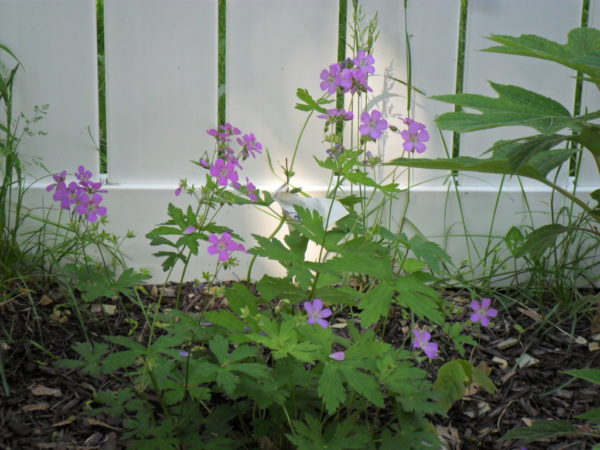
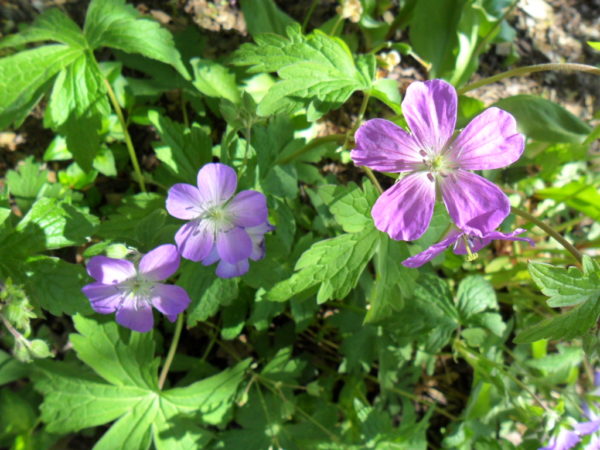
Native geraniums are the tallest of my spring woodland bloomers, ranging up to almost two feet, and their foliage will in fact persist until frost, unlike most in the ephemeral class (one pink-blossomed variety I had purchased earlier actually remains evergreen over the winter!). The purple variety I acquired last spring came up well then, but didn’t bloom; however, in year two they outdid themselves, covered in masses of delicate lavender flowers, and will likely provide occasional rebloom through the growing season.

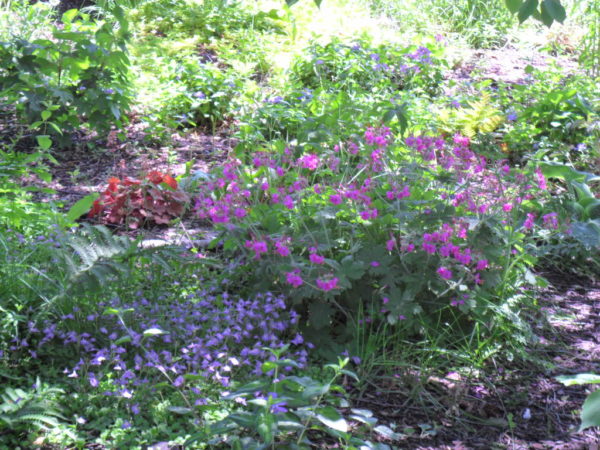
Mertensia, AKA “Virginia bluebells”, is another tall plant, with bunches of bright blue, downward-facing bugle-shaped flowers borne on 18” spikes. Although vigorous, mine have yet to bloom, and likely won’t before next year. But hepatica acutiloba, the Sharp-lobed Liverleaf, outdid itself in 2022. Last year it didn’t emerge at all, but it was one of the earliest arrivals this spring, sending sweet six-petaled blossoms of palest pink on ramrod-straight dark stems, rising another inch or so above the speckled brown-and-green foliage.

Three local natives I was bound and determined to have were arisaema, AKA Jack-in-the-pulpit; podophyllum, the so-called Mayapple; and erythronium, my most-beloved dogtooth violet, AKA “trout lily” (though it’s neither a violet nor a lily). Seeing them brings back vivid memories of springtimes from my childhood, accompanying my father on fishing expeditions to the local creeks, where I spent more time investigating the flora that angling for the fauna.

The Jacks and the Mayapples did very well in their first year, with 100% returning for year two. The Mayapples are obviously thriving now, adding smaller side shoots with miniature versions of their mottled, umbrellalike leaves. They have yet to bloom or fruit, but since the blossom is a fairly nondescript, downturned white affair difficult to see, close-held on the underside of the canopy, and the fruit is inedible, I’m not too bothered by that. The Jacks, on the other hand, I do want bloom from, and I got a few in that first season, but none this year. But they, too, are spreading, and hopefully by next year I’ll be rewarded with the green hoods striped with purple-brown, covering a pale green-white spadex, yielding dazzlingly crimson red compound fruits in autumn that look like overlarge raspberries.
The dogtooth violet, on the other hand, has been a trial. The initial plants I was sent were soft and rotting when they arrived. The reshipment looked much better, but was also more advanced, already sprouted, each with a single mottled brown-and-green leaf attached to its tuber by a long, delicate white stem. Well, attached at one point, that is – unfortunately the grower had sent these in a mailing envelope, not a box, and the battering they received during shipment broke most of the leaves off. We planted them anyway, but they never resprouted, and the ones whose leaves were still attached quickly faded and died.

I decided to regroup, and in desperation I ordered a different strain, from a different grower, last autumn. These are Pagoda erythronium, similar to dogtooth violets but more robust, with several bright yellow blossoms per stem, hanging at intervals like a Japanese temple design. They did extremely well this year, but don’t quite scratch the itch I had for my boyhood woodland favorites.
So I was shocked, and more than pleased, to find that, against all odds, some of last year’s abortive second batch of native dogtooths actually emerged this spring! I had kept the area watered, and somehow they had lain there a full twelvemonth, alive but in statis. They offered but a few small leaves this season, and it may be years before they bloom, if they ever do, but at least there’s hope.
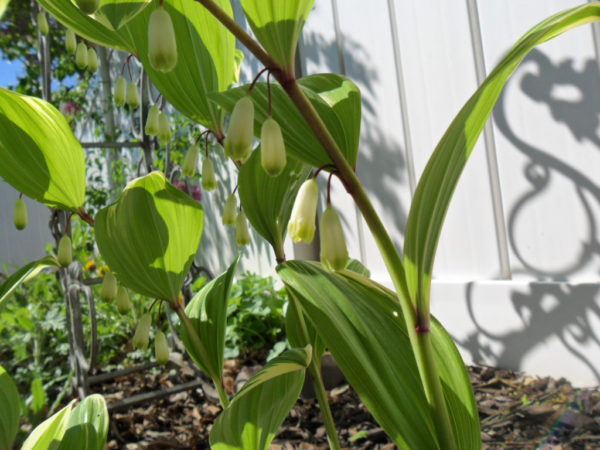
Polygonatum, commonly known as Solomon’s Seal, is another woodland favorite from my childhood. Last year I invested in a small pot from the perennial farm, which has doubled in size this spring, the beginnings of what I hope will be a very dense, far-reaching colony someday. Solomon’s Seal is a late May bloomer, with tall, 18” arching stems that radiate spear tip-shaped green-and-white leaves, beneath which hang pairs of delicate, bell-shaped white blossoms.
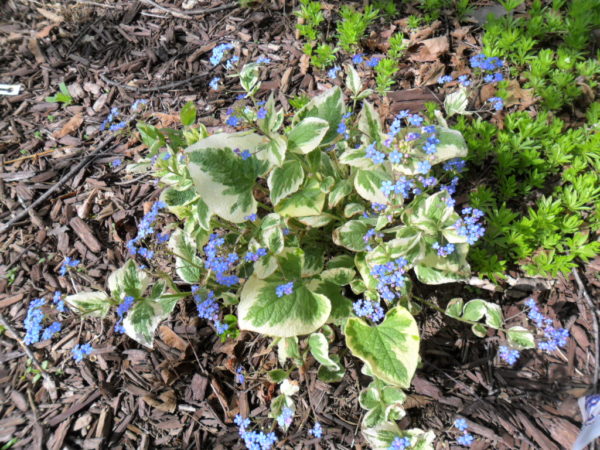
Brunera was a total mystery to me when I encountered it at the perennial farm three years ago. But, always a sucker for variegated species, I was intrigued by its mint-green foliage with wide creamy margins. I bought it in June, and Kay informed me that it had already bloomed for the year, but I decided to defer gratification and plant it anyway, and l’m so glad I did! The next spring, I was surprised by how early the brunera was up-and-doing, sending out fresh wee shoots even before the crocus had bloomed. What really shocked me was how quickly it got up to speed and put forth blossoms, covered in clusters of small baby blue flowers that resemble forget-me-nots in late March, when most perennials haven’t even broken the soil. Brunera also flowers for a good three weeks, making it a marvelous addition to the early spring landscape.
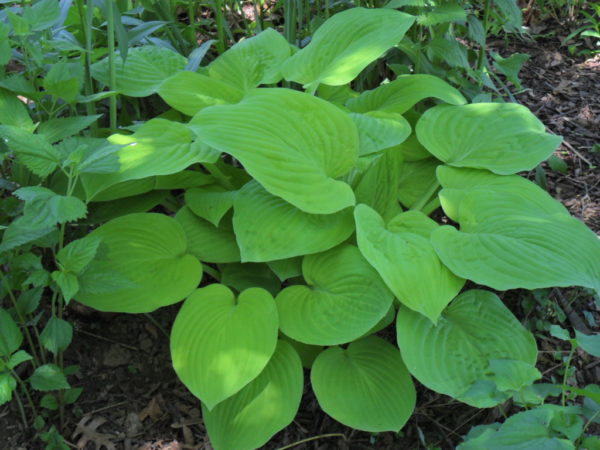
Most of the ferns, heucheras and hostas have returned well, though there has been a bit of attrition. Philosophically, when one plant fails to return, I simply pop another in its vacated hole. I have a wide array of hosta colors, from sedate emerald green through bluish tones to chartreuse, some smooth-leafed, some puckered. Variegated varieties, as always, are my favorites, and I have types edged in white, cream and yellow.

There is a dizzying array of heucheras on the market these days, and I must admit, I have indulged in more than a few. I grew this plant in pots in Philadelphia, but here they do better directly in the soil. Heucheras have a moderately large leaf, somewhat maple-shaped, and at some point in the growing season they send up tall spikes clustered with diminutive blossoms, often pale cream but sometimes matching the leaf color. The most common variety in my parents’ day was known as “Coral Bells”, medium green foliage with bright orange-pink blossoms. But breeders have been working overtime, and my garden now boasts specimens in lime green, chartreuse with burgundy veins, dusky rose, copper, deep burgundy splashed with pink, and even purple! Scattered across the landscape they offer a welcome color boost when the spring flowering season is past, and the shade garden retreats to tones of green.
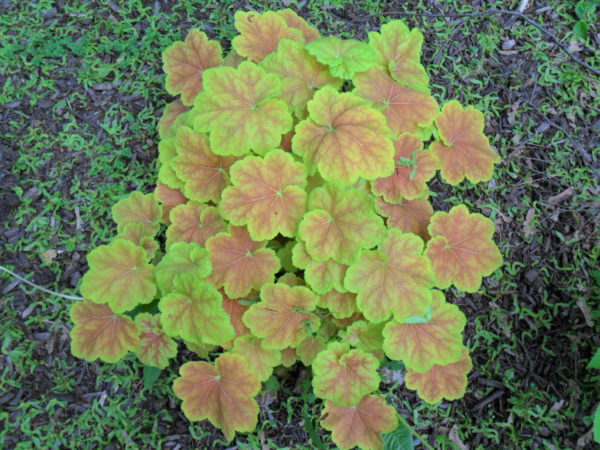
Another species with a lot of options on offer are ferns, of which two, the Sensitive fern and the Autumn fern, have done the best for me. Autumn fern’s initial fronds as they unfurl are bronzy-green and quite showy, a very compact plant, while Sensitive fern is both taller and more ethereal in its frond distribution, spreads well, and has doubled the acreage it covers in just one season. The Japanese painted ferns don’t do as well, but are returning reliably, making for an interesting contrast in dark green to silver and almost grey-black. Two unidentified fern varieties are also present – one is a very elegant, full-fronded beauty I originally acquired from a friend and transplanted from my Philly garden; the other I found here, waiting for me in an untended foundation bed, apparently self-sown. The Philly transplant has started to spread, which it does by underground rhizome action, with “babies” sprouting randomly across a six-foot diameter circle around the main plant.

The larger foundation plants are doing well overall, but I’m disappointed in the hydrangea bloom rate, which has been dismal. I have mostly oakleaf varieties, which bloom on old wood, and only one of four budded and bloomed last year. At the time, I attributed this to a late cold snap; oakleaf hydrangeas bloom on old wood, so a late freeze can decimate softening buds and eliminate bloom for an entire season. But they have no such excuse this year, and I see no sign of anything but leaf; though their actual bloom time is still weeks or months away, flower buds should be apparent now. I have one hydrangea of the arborescens variety, which blooms on new wood, and did so profusely last year; it has returned vigorously, so I’m hoping for a bumper crop of bloom from that one in due course.
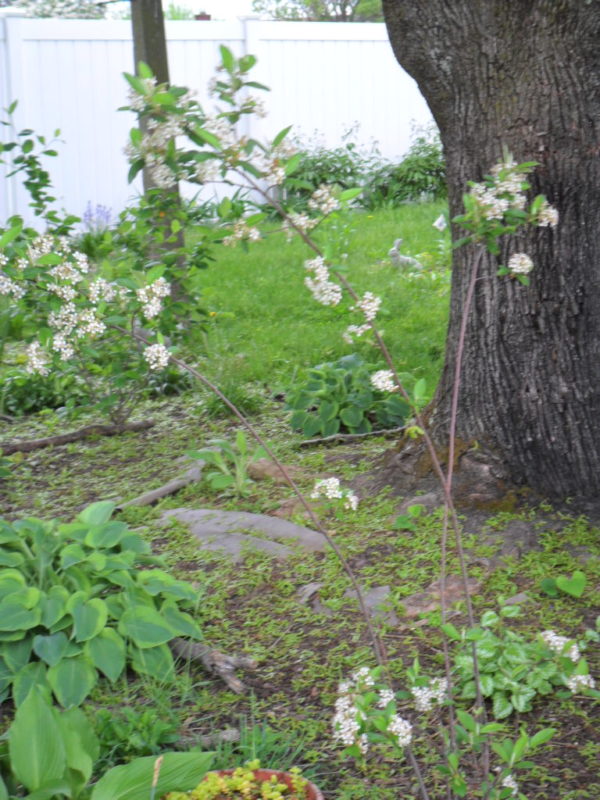
Both Aronia shrubs have bloomed this year, and are filling out well. Brilliantissima, a red chokeberry, bloomed and fruited last year as well, but is really loaded this season. Viking, a black-fruited variety, bloomed not at all in its first year, but has favored me with a half-dozen clusters of blossom this spring. Both offer stunning red-orange fall foliage color, and are a good winter food source for birds.

The beautyberry’s return was disappointing to say the least, with less than half the shrub putting out fresh shoots this spring. I’m sure it will be awash with its small purple berries come the fall, but its shape will be lopsided and leave much to be desired. In time I’ll likely want to prune it to regularize the form, but for now I’ll let it run and be what it wants to be.
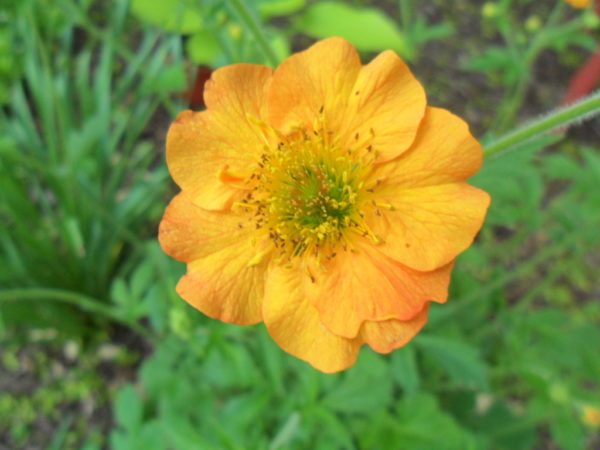
All that remains to remark upon are the Pagoda dogwoods, tiny sticks when I bought them two years ago, underplanted beneath the high canopy of the maple. I’ve been disappointed that they haven’t yet bloomed, but they are growing up very nicely, full-boughed and heavy-leafed. The larger is approaching four feet, quite a leap from its 12” height at purchase. In time they’ll help to fill in the shade gap created by the maple as it ages, thins and eventually fails, preserving my precious shade garden for years to come.


2 comments, add yours.
Cosmic Craig
Very nice work Alex! Thanks for sharing the photos.
Emma Esperanza Acosta
Lindo